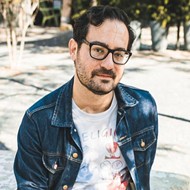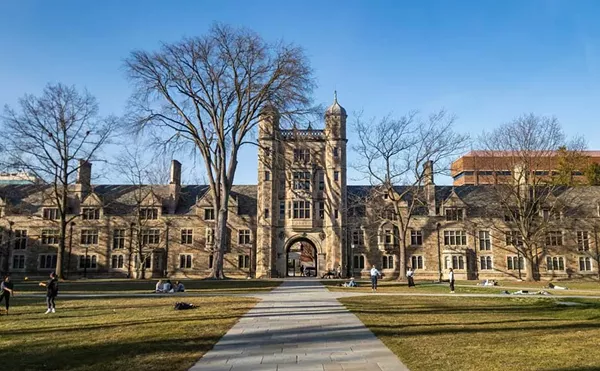Over at the Urban Neighborhood Initiatives (UNI) office, located farther up on Springwells Street from the viaduct, executive director Dennis Nordmoe is obsessed with maps. "I've been map-crazy," he admits, showing us various ways of defining Southwest Detroit.
It's a huge swath of land, which Nordmoe says encompasses 75,000 people depending on where you draw the boundaries. He shows us a map of the Detroit Police Department's Fourth Precinct and another of the recently instated Detroit City Council District 6, represented by councilwoman Raquel Castañeda-Lopez.
He then pulls out a computer printout of an old region map from 1893. "Notice the boundary of the city of Detroit is right there, around Livernois," he says. Outside of city limits to the west was a sizeable chunk of land called Springwells Township, which would later get incorporated into Dearborn and Detroit, forming what would become what we now call Southwest Detroit. Essentially, with Springwells Village, Nordmoe and UNI are reviving a defunct brand.
Nordmoe's propensity for cartography, he says, comes from his days working for the city of Detroit, where he spent 30 years working in substance abuse services mapping data and doing prevention planning work. And that's when he realized the importance of social work on the neighborhood level.
"I could see agencies would claim to be comprehensive, when really they scattered a lot of separate services all across the city," he says. "That doesn't make it comprehensive for a kid growing up in a neighborhood. It's like the old 'five blind men and the elephant' — like, 'OK, I got the tail,'" he says.
Nordmoe says when he did dissertation research on drug-related mortality and homicide he found that the No. 1 driver was the education levels in a community. But the second-largest driver was city size. "The bigger the space you're in, the less rigid the norms are," he says. "If you're in a village, you're in a community where you feel accountable."
As the old adage goes, "It takes a village to raise a child."
"So how do you get back to the village?" Nordmoe says. "One way is to strengthen the neighborhood, to make the neighborhood so stable, so positive, that you get your identity there, and you feel your support group there."
After living in northwest Detroit for 30 years, Nordmoe moved to Huntington Woods 17 years ago when he first started working in Southwest Detroit, taking a job that seemed like it would offer an opportunity for him to work on a neighborhood level like he envisioned. One of his first projects was to rehab an abandoned church into the All Saints Neighborhood Center, a project that he says occupied most of his time between 1997 and 2005.
Things grew from there. A priest at All Saints suggested Nordmoe next try to acquire the empty lots across the street to use for parking for the community center. "I thought, 'Parking? A park would be better,'" he says. "Everybody in the neighborhood was saying there was nothing for kids to do."
By all accounts, the community center and park were a success. "That building was rocking from 7 in the morning to 9 at night, five days a week," Nordmoe says. "We've got a paved trail that goes all the way around. We see people of all ages using it. A young man working out, women walking it in groups, grandmas pushing strollers, kids on bikes, teenagers on rollerblades and skateboards."
Nordmoe says the park was embraced by all members of the community. "I was getting out of my car one day, and a [homeless] man comes down the street pushing his shopping cart with his stuff," he says. "And he stops by me and he says, 'This is wonderful. This is amazing. This is stupendous. Now if we can just keep the riffraff out!'"
In that way, Nordmoe says it's the ideal community — people with money love the neighborhood enough to stay and invest and raise their families, but the people who don't have money still feel bonded to it too.
"I thought, 'This is different. It is like a village here,'" he says, noting that it even has its own miniature downtown at the intersection of Vernors Highway and Springwells. "I started noticing that life here was different. People knew each other."
Nordmoe says that though you might walk into a liquor store or grocery store and be separated from the clerk by a plastic partition, you hear people addressing each other across it by name. "It's the first place that I've been known exclusively by my first name. None of this 'Dr. Nordmoe' or 'Mr. Nordmoe,' he says. "It just doesn't occur to them. It's not disrespectful — it's just 'Dennis.' Little kids, old people — 'Hi Dennis!' It feels great."
Nordmoe shows us another map. This is one that UNI made, a postcard with some of the information from the Springwells Village website printed on it.
"I noticed there was a natural community here," he says. "I was taught in geography to look for natural barriers. There's a natural land barrier here" — he points to the freeway and the industrial strip to the south — "and here" — he indicates Woodmere Cemetery on the west and Patton Memorial Park to the north.
"If you're driving around Detroit, you don't drive through these rail yards to anywhere," he says. "You go around it. Which has maybe been a blessing — it's allowed this neighborhood to nurture its own character."
As a result, though, the community isn't known as a destination for a lot of Detroiters — hence UNI's postcards. "This is a very entrepreneurial neighborhood. Everybody wants to start a restaurant. But how many restaurants can 17,000 people support?" he asks, referencing the approximate population of the area. "And yet, these are very worthy enterprises. How do you market that? You say 'Southwest Detroit,' and people think Mexicantown. No, it's not Mexicantown — Mexicantown is a piece of Southwest Detroit."
Names arise out of necessity. Internally, UNI came up with other names to address even smaller communities within the area: "Patton" after the nearby Patton Park, "Clemente" after the nearby Roberto Clemente Academy, "Woodmere" after the cemetery, "Springdale" after its bordering streets Springwells and Lawndale. "There's nothing particularly imaginative about it," Nordmoe says. "But it helps us to understand. It breaks it down so that if we visited 2,000 homes, but we didn't [visit] Clemente, we didn't really do the whole community."
Nordmoe says these names were only really used at the staff level. "But if you told anybody, 'Are you up in the Patton neighborhood?' They'd probably say, 'Oh yeah, we're by Patton Park.' But they wouldn't themselves say that," he says.
Eventually, Nordmoe says there came a need to name their efforts in the larger community, both internally and when applying for grants. That's when the idea to reclaim Springwells Township's identity came about. Again, the name was not particularly imaginative, as Springwells Street is a major thoroughfare, and there's also the Springwells Post Office still in use. "The consensus was, 'Let's go with Springwells,'" Nordmoe says.
Nordmoe cites a poster from 2000 promoting the Springwells Village project, noting at least a dozen other agencies' involvement. He also shows us a booklet outlining the Springwells Village Quality of Life Plan, which features more than 500 collaborators. His point: Nobody voiced any concerns about the Springwells Village name back then.
"All through that process, there was no objection to the name," Nordmoe says. "That name had been in use, by that time, for 10 years — for more than 10 years."
It was only when UNI had nearly finalized a contract with a marketing agency that the controversy brewed.
"There are some people who've made the issue a cause for whatever reason, and some reasons are given," he says. "One reason that I find implausible — and I'm willing to discuss it — is when you name a community, that leads to gentrification." Nordmoe pauses. "Didn't work for Brightmoor."
Nordmoe is reluctant himself to use the word "gentrification" — as are members of Enclave, it should be noted — pointing out that the neighborhood has lost thousands of people in the past decade. "If Detroit weren't missing a million people, and this was some kind of high-powered development process of seizing territory and chasing everybody out and redeveloping it for high income brackets — yeah, I'd get that," he says. "But that's not it. The whole purpose here is to help an ordinary Detroit neighborhood prosper and be a stable, mixed-income neighborhood that people are proud of. To get the resources there."
Nordmoe acknowledges a top complaint of the opponents to the Springwells Village name — that there wasn't enough community participation regarding the name. "There are single-issue people. God bless them, they get their issues advanced," he says. "There's only so much community participation that any of us are capable of. We had a lot of community participation. Did we have a maximum amount on every single issue? Well, no. But you still go forward with what you have."
Nordmoe is also aware of the suspicions that gentrification is the driving force behind the name. "I know that downtown, low-income, elderly people are being moved out in an insensitive way. But, why were they there in the first place? Because downtown was so degraded as a commercial location that they used it for purposes it wasn't built for. That's not really gentrification — it's recovery," he says.
"Now, it should be done with respect. But what we're about, post-recession, is getting [home] values up anywhere near where they were before the recession, and getting these restaurants that keep going out of business really successful, getting the storefronts that are empty filled again — and No. 1, helping the people in the neighborhood to prosper. And as they prosper, so improve the neighborhood that they will stay instead of move to Lincoln Park. This neighborhood becomes a success when those people stay.
"Prosperity is not the same as gentrification," he adds.







